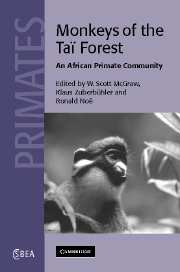Book contents
- Frontmatter
- Contents
- List of Contributors
- Preface
- 1 The monkeys of the Taï forest: an introduction
- Part I Social behavior
- Part II Anti-predation strategies
- 5 Interaction between leopard and monkeys
- 6 Interactions between red colobus monkeys and chimpanzees
- 7 Interactions between African crowned eagles and their prey community
- 8 Monkey alarm calls
- Part III Habitat use
- Part IV Conservation
- Appendix
- Index
- Plate section
- References
8 - Monkey alarm calls
Published online by Cambridge University Press: 30 July 2009
- Frontmatter
- Contents
- List of Contributors
- Preface
- 1 The monkeys of the Taï forest: an introduction
- Part I Social behavior
- Part II Anti-predation strategies
- 5 Interaction between leopard and monkeys
- 6 Interactions between red colobus monkeys and chimpanzees
- 7 Interactions between African crowned eagles and their prey community
- 8 Monkey alarm calls
- Part III Habitat use
- Part IV Conservation
- Appendix
- Index
- Plate section
- References
Summary
Introduction
Most primates vocalize when threatened by a predator. These signals, usually termed alarm calls (from old Italian “all arme” = “to arms” on the approach of an enemy), are interesting for a number of reasons. First, they are relatively uncomplicated to examine. Alarm calls are typically highly discrete signals, and it is thus often not difficult to study both causes and consequences of this behavior. Second, alarm calls are interesting because they pose a problem for evolutionary theory. Paradoxically, they are often amongst the most prominent and noticeable signals in a species' repertoire. But why should an individual behave conspicuously in the presence of a predator, hereby revealing its presence and location? Finally, alarm calls have obtained some significance for the empirical study of pre-linguistic abilities. Alarm calls are unique because they are well suited for experimental work and so provide a unique tool for empirically accessing the cognitive mechanisms underlying an individual's behavior.
The purpose of this chapter is to review some key findings in the study of primate alarm calling behavior. The first section is devoted to the problem of why primates produce seemingly maladaptive behavior in the presence of a predator. Which evolutionary processes could have provided a selective advantage for individuals to behave in this counter-intuitive way? A second section is concerned with the cognitive processes that underlie call production and perception.
- Type
- Chapter
- Information
- Monkeys of the Taï ForestAn African Primate Community, pp. 194 - 220Publisher: Cambridge University PressPrint publication year: 2007



